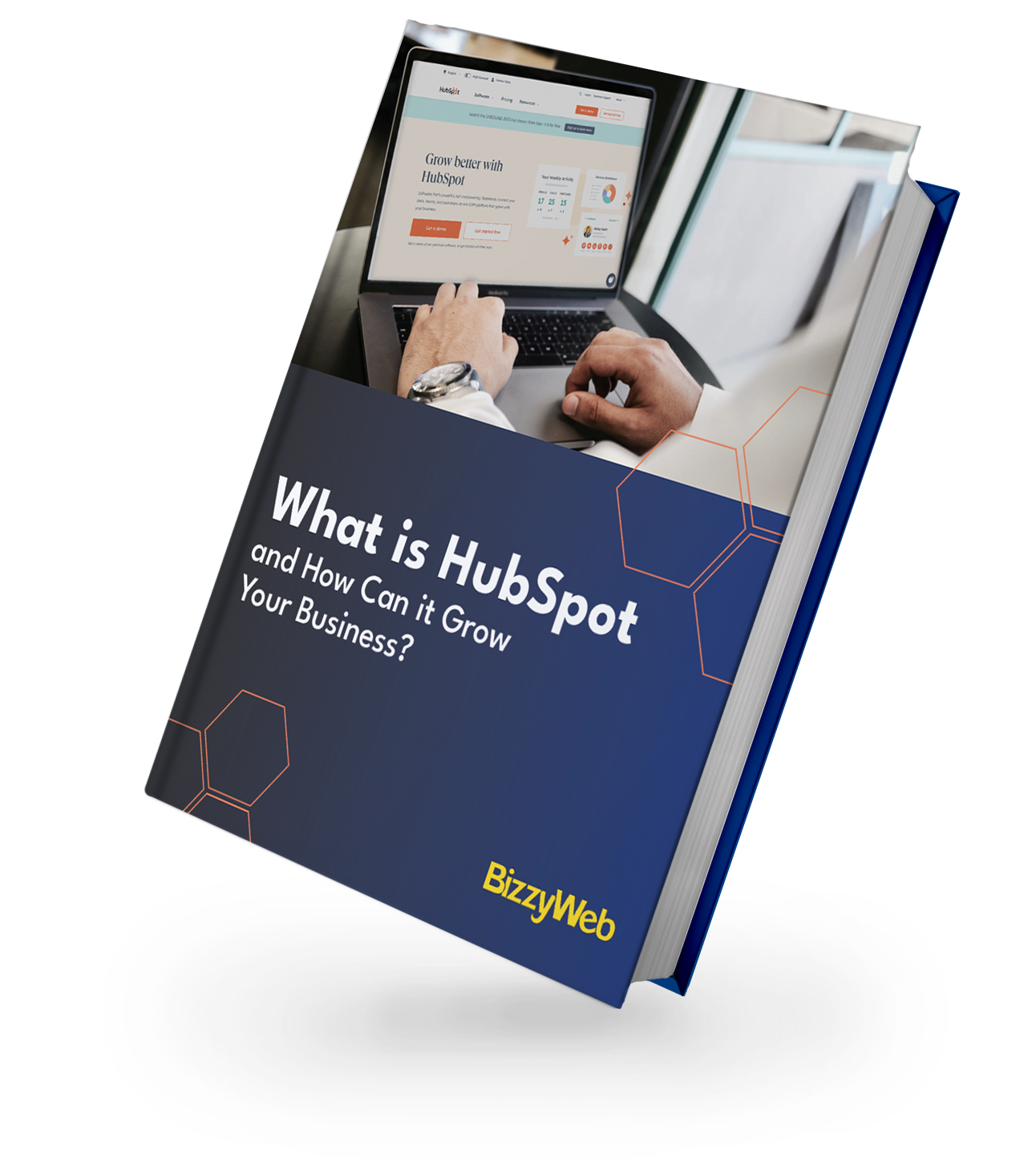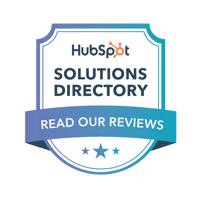HubSpot Marketing Hub
While it’s easy to get lost in the what of marketing - writing that blog or sharing that social post - the how can often be forgotten. Marketing Hub is the how. It delivers an all-in-one platform for marketing, from creating content to sharing and measuring its impact.
Marketers know that their efforts are about far more than generating instant leads; it's about crafting the journey a contact will take: from their initial attraction to your message, the tipping point where they begin engaging with what you have to say, through to delivering them satisfaction with the promise you made during the story you’ve told them along the way.
Accomplishing all that takes a lot of time and energy, and you want to ensure your team can spend as much time as possible doing the work only they can do - creating excellent stories and building genuine points of connection with your audience. Learning more about Marketing Hub will help you understand what parts of HubSpot can give your team all that time back and if HubSpot itself is suitable for your organization.
Marketing Hub is - like the name implies - the core suite of marketing tools within HubSpot. Tools like Emails, Social Media, SEO, CTAs, Campaigns, and Workflows are just some of the capabilities your team will have access to with Marketing Hub. This Hub is one of the most robust within the HubSpot platform, as it grew from its original purpose in marketing automation to the in-depth CRM that provides functionality for your entire organization that it is today.
With HubSpot Marketing Hub, you can give your Marketing Team a tool that takes the brunt of the manual labor off their hands while simultaneously adding additional capabilities to their efforts that would have been impossible to accomplish before.

Structure: Emails, Ads, and Social Media
When we look at the Structure parts of Marketing Hub, we look at the core components, the essential tools that make up the suite of marketing tools within the platform.
Emails
Emails are one of the most iconic tools in marketing in general and are, of course, a must-have in any marketing automation tool. Within HubSpot, you’ll notice a similar theme as we look at the other parts of Marketing Hub; you’ll see a creation and editing tool that is very intuitive and designed with marketers in mind. While you will still have the option to have your dev team build an email with code if you were so inclined, you can use the tool to quickly and easily create engaging and beautiful emails with no more effort than a simple drag and drop of the sections you want to have in your email.
Once your fantastic email is ready to go, you can schedule your send in advance, create a compelling and personalized subject line, and filter your target audience to receive that great email with as much or as little detail as you want. And you won’t want to forget one of the most exciting parts of emails - using them in automation. (Check out automation below to learn more about how that works!)
Ads
Paid Ads are a crucial component of the inbound marketing efforts for many organizations, and understanding their actual impact is invaluable when deciding how to allocate your budget and efforts. Within Marketing Hub, you’ll be able to connect your Ad accounts from Facebook, LinkedIn and Google and, in turn, see the results of your ads across those networks. You’ll be able to see not only the reach of your ads but the actual revenue generated and ROI of those ads.
Social Media
The final core structure component of Marketing Hub is Social Media, which allows your team to push and pull on Social Media, creating and scheduling content with ease while seeing the results and impact of that content. Once you connect your accounts across Facebook, Instagram, LinkedIn and X (Twitter), your team can write your posts, add relevant images, important tags and mentions and more without leaving HubSpot. You can see and analyze the usual “vanity” metrics, your followers, impressions, and the like, but also the more critical metrics - the number of actual leads, revenue generated, and ROI, among others.

Everything You Ever Wanted to Know About HubSpot
Discover how to grow your business with an all-in-one sales, marketing, website, customer service, and CRM powerhouse. Explore the power of HubSpot and its 5 Hubs to decide if it's right for your business and growth goals.

Time Savers: SEO and Files
While almost every part of Marketing Hub is designed to help your team save time in their day-to-day efforts, SEO and Files, in particular, significantly boost your teams’ productivity.
SEO
As any SEO expert can tell you, there are a lot of moving parts and ongoing work needed to stay on top of your SEO efforts. Rather than waiting for a drop in traffic to indicate a problem, or perhaps even worse, losing out on that traffic from the very start, using the SEO tool in HubSpot gives you a great place to correct issues within your site right away and monitor pages for new problems appearing as well. You’ll be able to scan your website and see not only the issues on your site but also:
- The urgency of errors
- What areas are being affected
- The technical difficulty to resolve
- What teams will likely be needed to correct them
Which makes the process of resolving issues much simpler.
Files
How much time does your team spend looking for the right copy of this image or that PDF or ensuring that the sales team has the most up-to-date copy of your latest brochure? With Files, your team can easily store and access the content you need to use in your marketing efforts. Not only that, but you can replace an existing file with a new version and have that file update everywhere that links to the file in real-time, never having to worry about finding all the places on your site or emails your team is sending where that file is being referenced and updating links.
Automation: Workflows
Welcome to the powerhouse of Marketing Hub - Workflows. While all the other Marketing Hub tools will help create and share your content or measure the results of your efforts, workflows will go beyond that.
Workflows can be used two ways: for internal processes, and for external communications.
Internal Processes
You can use workflows to automate internal processes - perhaps you want to make it so that every contact at a particular company has the company phone number listed on their record and any time that company phone number is updated, you will, of course, want all of the contacts at that company to be updated as well. Without workflows, this would be time-consuming and irritating; instead, you can create a workflow that will run in the background to do this entire process for you, with no additional input needed.
External Communications
The fun part of workflows is the automatic follow-up and outreach to contacts. Whether you want to create an outreach campaign that sends a series of emails to a contact who fills out a form, perhaps to re-engage a contact that spoke to sales last year, or to encourage registrations for an upcoming webinar along with follow-up after the event, workflows will allow you to automate the entire process.
Additionally, with the data available in HubSpot you can do so intelligently. Send customers relevant follow ups based on their data and how they interact with your site. The possibilities are endless:
- Abandoned cart workflows
- Recommended products/services based on website activity
- Referral codes and discounts after converting
- Personalized content based on data and behavior
Related Content: 5 Essential HubSpot Workflows to Copy

Measurement: Reports, Dashboards, and Campaigns
Creating content and connecting with contacts is all well and good, but if you aren’t measuring the outcomes of your efforts, you are not only working blind, but you will likely have a lot of pushback from leadership to justify your work and role.
Reports
Marketing Hub provides a fantastic reporting tool with plenty of out-of-the-box reports on everything from your website traffic to the revenue generated from a particular series of social media posts. And while out-of-the-box reports can be great, if you need to dig deeper, get more granular, or just have specific needs to answer critical questions unique to your organization, you can easily use the report builder to analyze your data and share your results.
Related Content: Marketing Attribution Reporting: Why it Matters and How to Do It
Dashboards
No reporting tool would be complete without a place for those reports to live, which is where dashboards come into play. Adding a set of reports to a particular dashboard, from executive-level reporting to helping a BDR see their weekly activities and results, lets your data tell your stories in real-time.
Campaigns
Now, reports and dashboards are fantastic ways to get granular with your data, to dig deep and paint a picture, but what if you need to see that 1000-foot view of your efforts? Then, you want to look at Campaigns. Within Campaigns, you can add practically every type of asset across the entire platform, from emails and landing pages to paid ad campaigns and workflows, to see the impact of these assets combined. You may want to understand how your entire webinar program has impacted your revenue or how a particular campaign grew the sales pipeline; with Campaigns, you can combine all of these related assets in one place to see their collective results.

Persuasion: CTAs and Forms
We come to the last components of Marketing Hub - the tools of persuasion. What we are actually talking about here, of course, are points of conversion. This is not to say that contacts don’t convert through other tools, but these particular tools are the most common mechanisms by which contacts are identified in your portal.
CTAs
Most marketers are very familiar with the term CTA - Call to Action, but within Marketing Hub, CTA takes on an additional meaning as an actual tool within the platform. The CTA tool allows your marketing team to create graphics and buttons that appear as pop-ups, banners or embedded in emails and website pages - no coding experience needed. You have complete control over how and when they appear on your site, from scroll percentages to time on page, and showing on every page, specific pages or every page but these few. These CTAs are not only visually appealing; they can incorporate other elements of Marketing Hub, like including a form or linking to a landing page. Tracking is a huge component of CTAs, and you will have great insight into the performance of this asset, from views to clicks and conversions.
Forms
While you may already have forms on your website, switching to using the forms natively in HubSpot Marketing Hub can be a massive lift in managing them and in the data and details you can gather from those form submissions. Creating or editing a form with the Forms tool is as simple as dragging the fields you want onto the form or off, with creative control to write whatever you wish visitors could see for any given question. There are several familiar features within Forms, like conditional fields - showing a different field based on their answer to a previous question, or progressive fields - removing a question if the contact is already identified and asking another question instead to gather more information.
You can notify your team of submissions, start an automated follow-up campaign after submission, and direct the visitor to a new page, all within your form settings. Your forms can be connected to any workflows, campaigns, landing pages, or any other tool in the portal to gather the information you need to better understand and communicate with your contacts.

Download Now: The Ultimate Guide to HubSpot
Explore the power of HubSpot to decide if it's right for your business and growth goals. This ultimate guide covers:
- What exactly HubSpot is and what it does.
- A breakdown of the CRM and 5 core Hubs.
- How to get started with HubSpot implementation.
Marketing Hub: What’s in it for me? (WIIFM)
Now that you know the what and how of Marketing Hub, it’s time to address the why. Why is investing in Marketing Hub a worthwhile cost for your business?
One place for everything
There are an enormous number of tools and websites available on the market. Unfortunately, with so many options, most marketers use dozens of tools daily - some that play nicely with others and some that force marketers to spend hours copying details from one system to another. This doubling of time occurs both on routine tasks and when it comes time to report on marketing efforts - which often creates wide gaps. Additionally, data doesn’t always flow from one system to another, causing you to lose valuable information.
With Marketing Hub, your team reduces the time wasted on broken or inefficient integrations, improves the consistency of your brand, and makes it faster to educate and train your team. When creating, distributing, and reporting on marketing content, having a single platform where everything lives is the best approach.
We take a closer look at the actual problems of this multi-tool approach here: The Hidden Costs of FrankenMarketing
Do more with less
Marketers are constantly being asked to do more with less. And there are only so many efficiencies to be gained in any marketing process. Eventually, you have to look at not only the processes but also the systems around them.
Having a platform that provides a consolidated approach to marketing allows your team to save time moving between systems and sites. Additionally, the automation tools within HubSpot eliminate time spent on menial, manual tasks - like sending out notifications and reminders. Finally, Workflows supercharge marketing campaigns and deliver more personalized - and thus better resonating and converting - content to the right contacts at the right time.
Understanding ROI in terms of Revenue
Measuring the ROI on marketing efforts is often seen at its best as a challenge and at its worst as impossible. By bringing many channels into one tool for measurement - your website, social media, email, and ads - you can create a much clearer vision of your buyer's journey. Through this, you tie more apparent ROI to your marketing efforts. Without HubSpot, you lack this visibility into your buyer’s complete path and every activity along the way.
Because HubSpot Marketing Hub integrates with the FREE HubSpot CRM, you have a full lifespan of a lead’s data: from initial impression to the revenue from their converted deal.
Learn more about marketing attribution here: Marketing Attribution Reporting: Why it Matters and How to Do It
HubSpot’s robust reporting tools allow marketers to translate these complex journeys into easy-to-understand graphics that can be shared with leadership and sales. Use the extensive gallery of pre-built reports or customize your own to report on the data that matters the most.
Choosing your Hub Tier
Marketing Hub comes in a few different tiers - understanding which one is right for your business is a crucial aspect of building your HubSpot portal. Let’s take a quick overview of the main differences you can expect between Marketing Hub Starter, Professional, and Enterprise.
One quick definition to help you understand the breakdowns below is Marketing Contacts. In HubSpot Marketing Hub, you pay for the number of contacts you want to “market” to, that is, contacts you target with marketing emails and ads. You can store up to 15 million other contacts for free, and while sales can do outreach to these contacts and their activity will still be tracked, they cannot be sent marketing emails.
Please note that at each level, Marketing Hub is sold by the Core Seat - which gives those users the capability of having full edit access within the Hub. You can also get an unlimited number of View Only seats, which allow certain users to just view reporting, CRM and day-to-day activities.
Starter
With Starter, you will have the essential tools you need for marketing efforts, mainly giving you continued access to the free versions of the Hub, but with HubSpot branding removed. You will also have 1,000 marketing contacts included in this tier, but you can add more in buckets of 1,000. Your marketing email sending limit will be 5x your marketing contact tier.
Generally speaking, you will have access to several tools but only part of the full suite in Marketing Hub. However, this can be an excellent option for organizations with little marketing or are smaller, such as start-ups or small businesses with a smaller customer base.
Professional
At Professional, you will unlock almost all tools within Marketing Hub, including all the tools you can access in Starter, but also Workflows, Social Media, Campaigns, and Custom Reporting. You start with 2,000 marketing contacts and can increase in buckets of 5,000 here, but you get 10x your marketing contact tier in marketing emails. You will find numerous additional features and capabilities for almost every tool in Marketing Hub, from increased limits to advanced recommendations and options. With Professional, you will get ABM tools like lead scoring, SEO Analytics, Dynamic Personalization - showing contacts unique content based on who they are, and many other features to fully equip your marketing team for success.
This is an ideal option for most growing or mid-sized businesses to have a comprehensive marketing solution. marketing Professional Hub comes with three Core Seats, and additional seats can be added.
Enterprise
Larger organizations often have increased needs for a customized solution that can be flexible enough to fit into their existing structures and processes rather than the other way around. Enterprise is designed to meet these needs and ensure the portal can fulfill your needs even as you grow or if you are already at that level and coming into HubSpot new. Some of the additional features included with Enterprise include Custom Objects - maybe contacts and companies aren’t detailed and specific enough to accurately depict your business, so you need a custom record type that can hold anything, perhaps locations, shipments, or events. You will also see a significant increase in many of the existing limits within the platform as you start with 10,000 marketing contacts included, growing in buckets of 10,000 with a 20x email sending limit, or an increase in the number of social media accounts you can connect, going from the 50 available in Professional up to 300 in Enterprise.
Enterprise is best suited to larger organizations or those with a higher need for a customized solution that offers increased capabilities across the board. Marketing Enterprise Hub comes with five Core Seats, and additional seats can be added.
Play Well with Other (Hubs)
While you can, of course, buy Marketing Hub as a standalone, just like any of the other Hubs, where you will see the most value and deliver the best results is by using Marketing Hub along with the other Hubs. Here are a few examples of what can happen when you bring two or more Hubs together.
Paired with Sales
Every organization is well aware of the importance of alignment between Sales and Marketing, yet many still need help with having it in any meaningful way. When you pair Marketing Hub with Sales Hub, you superpower the handoff from Marketing to Sales, allowing for things like automatic nurturing through marketing emails to leads that sales has marked as not quite ready yet or delivering MQLs directly to the sales team, routing from marketing forms to the correct member of the sales team at the right time.
Paired with Service
While Sales often sits between Marketing and Customer Success, for many organizations, a contact can go right from your website to being a customer, even if they have to work with sales in the middle, ensuring that the correct information is being gathered from the very start with Marketing to help support Customer Success is crucial in delivering a truly unified customer journey.
Paired with Content Hub - Marketing+
Marketing and Content Hub, of course, go hand in hand, as your website is a critical component of your marketing efforts. It only makes sense that having them all in one place would create a more cohesive and better-measured structure. That’s why Marketing+ Professional and Marketing+ Enterprise bundle the best of both worlds - comprehensive marketing software and AI-powered website building.
Paired with Operations
Operations is a unique Hub, as it doesn’t typically stand-alone but boosts the other Hubs. What this means for Marketing Hub is that the annoying work of cleaning up data as it comes in, or as is more common for most organizations, once in a blue moon when you realize how bad it’s gotten, can instead be automated. Take a first name, for example; many folks will enter it differently. One person may type their name as “john”, and another as “JOHN”, or perhaps even “jOhn” in error, but all of these will show a poor experience for that contact receiving your marketing emails using a contact’s first name. With Operations Hub, you can set automatic rules to clean this issue and ensure every first name field looks like “John” and comes off nice and clean in your email.
Paired with Commerce
The ability to take payments can be a great option for your contacts; whether you are looking at later in the sales cycle with your sales team or offering a self-service option to visitors, you can, as with most other parts of the platform, trigger automatic follow-up messaging and even tasks for your customer success team to reach out to your latest customers upon purchase.
*Payments are only available within the US currently.
Paired with Multiple Hubs
As you can imagine, bringing these various Hubs together is when HubSpot shines brightest. Having everything in one place allows for deeper reporting, smoother handoffs, and the ability to utilize complementary tools for each team that live within other Hubs, like sending a survey to a contact to understand their evaluation of your latest webinar when the survey tool lives in Service Hub. As you continue your HubSpot journey, you will continue to find more and more ways to combine the Hubs and the many amazing things you can accomplish with Marketing Hub and the rest of the platform.

We know HubSpot
Ready to learn more about the rest of HubSpot and how you can get started with your own implementation?
HubSpot Marketing Hub Onboarding from an Accredited HubSpot Diamond Partner
If you’ve made it all the way to the end, you probably are thinking: “this sounds complicated.” HubSpot is a powerful tool - and it takes a lot of time, effort and careful planning to unlock its full potential.
BizzyWeb is a HubSpot Diamond Partner and we offer full-service HubSpot onboarding, clean-up and strategy for all hubs. Our team has over 191 certifications in HubSpot (and constantly growing). No matter what your HubSpot needs are, our team is ready to handle them.
Plus, we’re one of the handful of agencies in the world that holds the brand-new HubSpot Onboarding Accreditation AND we are the only agency in Minnesota with a Platform Enablement Accreditation from HubSpot!
What We Do
- We work with you to learn your business, needs and goals - BizzyWeb is actively invested in making a solution that works for you, not just a standardized tool or an off-the-shelf install.
- Onboard, implement, and build - Once we’ve reviewed your systems and current data, we put our plan into action.
- Individualized training and reporting - When your setup is done, we’re not. We make sure you know to use your new HubSpot system, at your pace.
- Digital and inbound marketing programs for rapid growth - Make the most out of your HubSpot account with our digital marketing and/or inbound marketing services.
Related Content: When to DIY or Hire an Agency for HubSpot Implementation



